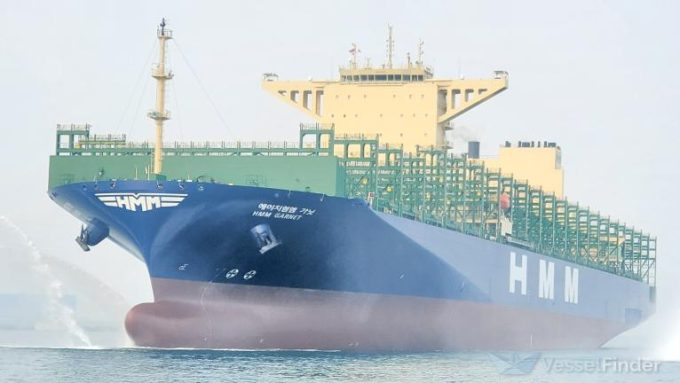Rhenus has a 'layered approach' to manage added supply chain disruptions
US port strikes, wars on two continents, shipping in crisis in the Red Sea: Rhenus ...
UPS: MULTI-MILLION PENALTY FOR UNFAIR EARNINGS DISCLOSUREWTC: PUNISHEDVW: UNDER PRESSUREKNIN: APAC LEADERSHIP WATCHZIM: TAKING PROFITPEP: MINOR HOLDINGS CONSOLIDATIONDHL: GREEN DEALBA: WIND OF CHANGEMAERSK: BULLISH CALLXPO: HEDGE FUNDS ENGINEF: CHOPPING BOARDWTC: NEW RECORDZIM: BALANCE SHEET IN CHECKZIM: SURGING
UPS: MULTI-MILLION PENALTY FOR UNFAIR EARNINGS DISCLOSUREWTC: PUNISHEDVW: UNDER PRESSUREKNIN: APAC LEADERSHIP WATCHZIM: TAKING PROFITPEP: MINOR HOLDINGS CONSOLIDATIONDHL: GREEN DEALBA: WIND OF CHANGEMAERSK: BULLISH CALLXPO: HEDGE FUNDS ENGINEF: CHOPPING BOARDWTC: NEW RECORDZIM: BALANCE SHEET IN CHECKZIM: SURGING

As anticipated, containership deployment trends in the first half of 2024 have been dictated by the situation in the Red Sea. The initial increase in deployment on main lane routes ex-East Asia that started in January has continued unabated through the middle of June. Unsurprisingly, the Far East-Europe trades, especially the Far East-Mediterranean route, have seen by far the most significant net capacity injections since the crisis started in November 2023.
Since the end of November 2023, a little over 1.7m teu of new containership capacity has left the shipyards (see chart 1). This figure is in line with the net change in deployed capacity on trades directly impacted by the Red Sea crisis, where Asia-Europe services have added 1.4m teu of extra capacity since the end of November, Europe-ME/ISC services 150,000 teu, and other affected ME/ISC services another 230,000 teu.
Given signs of strengthening demand, however, as well as some loss of fleet efficiency due to port congestion, a number of trades unaffected by the Red Sea crisis have also seen total deployed capacity increase over this timeframe, and in practice the source of these capacity changes has come from a large net drop in the volume of vessels either undergoing repairs (-312,000 teu) or that were commercially idle/not allocated to a trade at the time the crisis escalated (-370,000 teu).
So, while newbuild deliveries will continue to provide new capacity injections, beyond this the cupboard is looking increasingly bare for liner companies if they want to add extra capacity during peak season.
Capacity re-allocations
In practice, there has not been an extensive process (so far) of removing vessels from trade lanes unaffected by the Red Sea crisis, and instead allocating them to affected routes.
Leaving aside cases where capacity has dropped simply because liners have shifted away from running direct services in favour of relay and transhipment network structures (eg, a number of Europe-ME/ISC or intra-Middle East services), in the cases where trades have actually seen capacity reductions, these have been minimal in proportional terms (a 60,000 teu drop in Far East-ECNA deployment since the end of November, for example, is only equivalent to a 3% reduction).
It is more likely, however, that the capacity added to the ‘diverting’ trades has prevented capacity injections onto alternative trades that might otherwise have been justified and which very likely would be stemming or preventing the recent increase in freight rates.
So, while the intra-Asia trades have seen a small net uptick in capacity over the past several quarters, this masks an underlying trend where newbuild deliveries ordered by regional liners that do not serve trades that transit the Red Sea are being added to services, but at the same time older assets have been diverted away.
Chart 2 expands this point further, and suggests that, in most cases, liners are proceeding to add newbuild containerships to the trades they initially intended them for.
This of course applies to the 240,000 teu of 20,000 teu assets, as well as the trio of 16,500 teu methanol dual-fuel vessels that Maersk has received (as well as likely a pair of CMA CGM LNG dual-fuel newbuilds), that have been added to Asia-Europe services, but beyond that newbuilds have been added to ‘unaffected’ trades in large numbers.
The main possible ‘swing’ candidates, or exceptions, are 13,000 and 16,500 teu vessels operated by MSC, and four more operated by Evergreen or ONE. These vessels could in theory be allocated to long-haul routes away from Asia-Europe, but beyond these possible exceptions it does not appear liners have been diverting their newbuilds away from their originally intended trade routes.
This is guest post by Daniel Richards, associate director, Maritime Strategies International
Listen to the latest News in Brief Podcast for a quick recap of last week’s supply chain news and insight into what you might see this week:
Comment on this article